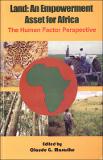| dc.contributor.author | Chirisa, Innocent | |
| dc.contributor.author | Bandauko, Elmond | |
| dc.contributor.author | Chikowore, Godfrey | |
| dc.coverage.spatial | Africa. | en |
| dc.date.accessioned | 2016-04-20T16:00:46Z | |
| dc.date.available | 2016-04-20T16:00:46Z | |
| dc.date.issued | 2014 | |
| dc.identifier.citation | Chirisa, I., Bandauko, E. and Chikowore, G. (2014) Urban land development in Africa. In: Mararike, C.G. (ed.) Land: an empowerment asset for Africa: the human factor perspective. Harare: UZ Publication, pp. 127-150. | en |
| dc.identifier.isbn | 978-1-77920-110-2 | |
| dc.identifier.uri | https://opendocs.ids.ac.uk/opendocs/handle/20.500.12413/11315 | |
| dc.description | A research paper on urban land development in Africa. | en |
| dc.description.abstract | Africa, with the most recent urban tradition and experience of city life, is currently urbanising at more than 4 per cent annually (UNHABITAT, 2010). In 1995, only 28 cities on the continent had populations exceeding one million. By 2005, this had grown to 43 cities, and it is expected that by 2015, there will be 59 African cities with populations exceeding One million. In the region, the urban population of 413 million (40 per cent) in 2010 is expected to rise to 569 million (45 per cent) in 2020 (Taipale, 2012). The high rate of rural to urban migration in African cities places central and local governments under pressure of providing housing for the ballooning urban populace. Largely, the housing demand is greater than the supply. Africa has been witnessing an unprecedented rate of urbanisation, which has resulted in rapid urban expansion beyond the control of local authorities and central governments alike. The outcomes are not always desirable. Many African countries have experienced increasing inequality, rising informality and mushrooming urban slums and informal settlements as well as low levels of quality of life. At the same time, the continent is experiencing vigorous and sustained economic growth. Much of this economic growth is riding on the back of the urbanisation process, as cities are engines of growth and development in the continent (UNHABITAT, 2010). We argue that the human factor is usually the main outstanding missing link in urban land development initiatives in Africa, a trend that then explains increasing urban poverty and inequalities among the local populations. | en |
| dc.language.iso | en | en |
| dc.publisher | University of Zimbabwe (UZ) Publications | en |
| dc.rights.uri | http://creativecommons.org/licenses/by-nc-nd/3.0/ | en |
| dc.subject | Development Policy | en |
| dc.subject | Environment | en |
| dc.subject | Industrial Development | en |
| dc.title | Urban land development in Africa | en |
| dc.type | Book chapter | en |
| dc.rights.holder | University of Zimbabwe (UZ) | en |


